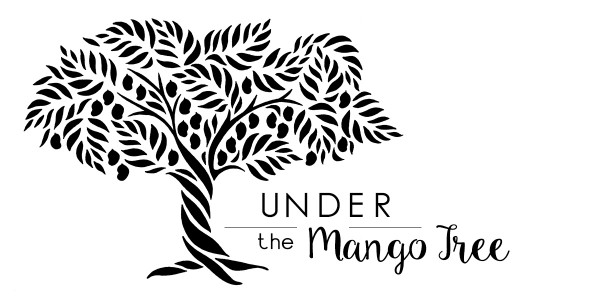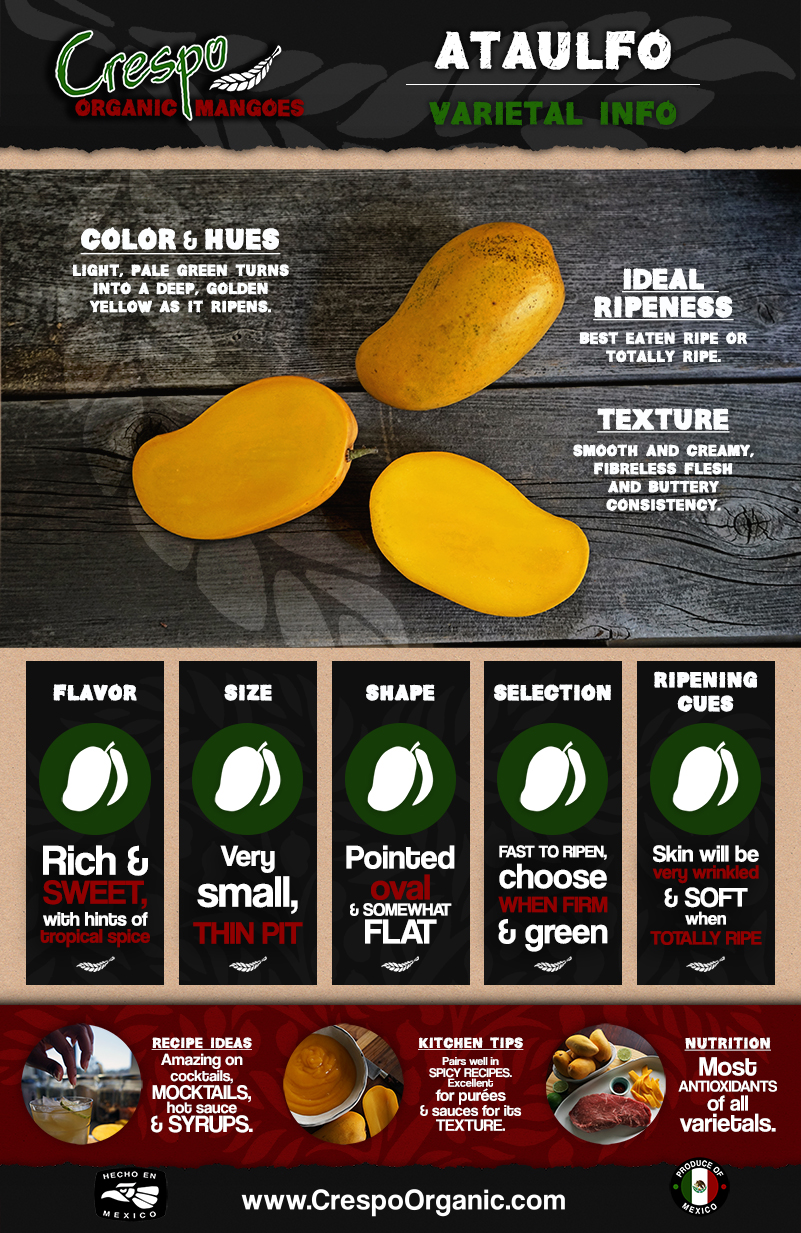Are we every really prepared for good things to end?
In recent years, Ataulfo mangoes have become a staple of many mango programs across the USA and Canada. Fruit eaters have warmed to this deliciously sweet and texturally silky mango. The path to increase consumer appreciation has not been easy for the Ataulfo, whose skin is most often blemished and overly wrinkled when it is perfectly ripe. Its shelf life is short, and bruises and scuffs tend to show up more on the Ataulfo – oftentimes showing up and disappearing and showing up and disappearing as the mango moves through the various stages of ripeness. Unlike its counterparts, the Ataulfo mango can only be eaten when ripe, so patience is a must and confusion among consumers regarding when it’s actually ready can be high. It’s Mexican name, celebrating its Mexican heritage, can be hard to pronounce for many North Americans, creating complications in education and marketing and spreading the joy for this mango varietal. Yet, despite all these obstacles, Mexico’s yellow slipper has succeeded, particularly in the organic sector, and especially as more consumers taste it and learn its nuances. Many retailers have succeeded greatly promoting this mango and sales have jumped in recent years. And now, just when everyone is used to its high dollar sales and consumer excitement, the season is ending.
The season starts in early February in Oaxaca, and it typically ends in mid-July in the Sinaloa region. It always surprises us, even though we know it’s coming. This season’s end, maybe because of all the chaos, took us a bit more by surprise than usual. But now we can report, its coming……..Expect the fruit to disappear by the end of July.
We will extend the season as long as we can as the Ataulfo is a really important varietal in our Crespo Organic program. We have not only increased the number of Ataulfo orchards and planted more for years ahead, but we also have a detailed program and systems that are designed to improve quality and extend shelf life throughout the season. This includes the art of selective harvesting, which we do every season in July to help our customers and consumers get a bit more time before the end. Each year we improve at this extension. It’s not a particularly easy or money-making method, unless you, like us, understand the importance of building and supporting consumer (and customer) interest. Extending the season through the end of July for our customers also helps us keep displays large and prices low during our Summer Mango Mania, which is one of the most crucial and voluminous points of the season. We expect to have fruit readily available through the first week of July and for the last three weeks of July for full-season program customers. Organics are rising in both popularity and demand, according to all the produce industry numbers. The popularity of organic mangoes are soaring, especially in late spring and early summer when weather gets hot, retailer data shows. The nearly full time addition of the Ataulfo mango to an organic mango program has proven to great larger and more successful mango programs for our customers and repeat mango customers at retail level season after season.
Although the Ataulfo tends to be most popular in specific regions, especially on the west coast, it seems to have the most success wherever its fully supported. We have seen this across the country and Canada: NYC, Philadelphia, Atlanta, Nashville, Minneapolis, Chicago, Denver, Seattle, Portland, San Francisco, Los Angeles, Phoenix, Austin, Vancouver, Montreal, and Toronto, to name a few of our hot pockets!
This ideal Crespo Organic mango program – in terms of the Ataulfo-starts with wholesalers that support our program and the DIRECT TRADE model. This contrasts with the brokerage system with way too many meddling hands operating far from the source. The direct trade model is the only model that consistently ensures the lowest price for consumers as well as the most direct and transparent line of information between grower and eater. A consistent fair price is the main driver of Ataulfo sales (assuming that quality, volume and size is delivered consistently). The majority of our Ataulfo customers have shifted Ataulfos from being a high-priced niche item to an everyday fair price item. This shift encourages consumers to try it and buy it and to make the purchase more frequently until the Ataulfo becomes a staple item. The Bay Area is probably one of the best examples of consumer support for the Ataulfo and thanks to the exclusive partnership we have made with Earls Organic Produce and the substantial amount of work we have all put in building the category there.
Educated and/or adventurous consumers are a key ingredient behind increasing Ataulfo sales (the Bay area has quite a few of these). Keep in mind that, if you have excellent wholesalers and retailers as partners, then you can create educated, adventurous consumers- where they may not exist. It does take work.
I’d be remiss not to mention that the expertise on our growing side remains central to the success of any mango program, and this expertise is critical to building, growing, and maintaining Ataulfo programs. Not only is it crucial to have an ALL season-long program, but it has to be big enough to offer multiple sizes in large quantities all season. Planning is key, if you ask the Crespo siblings Roberto and Jorge who are in charge of the crops. They acknowledge that their father, Roberto Crespo Fitch, had great foresight years ago when he began converting all of the Crespo family orchards to certified organic with the goal of 100% certified organic orchards, regardless of what box (CV or OG) the mangoes were packed in.
Today, el Grupo Crespo has a significant amount of proprietary acreage certified organic Ataulfo orchards between Chiapas, Nayarit and Sinaloa; with additional partnered orchards in Oaxaca. The trajectory, that Roberto began years back, has proven to be a major part of the family’s success. The family typically has plenty of volume to grow and maintain business, including new Ataulfo business. On the growing side, quality remains the main goal above all else. This is especially important with Ataulfos, as their general “ugliness” when ripe makes them difficult for consumers who are not in-the-know.
Which brings us to the last important component to a thriving Ataulfo program – consumer education. When all of the aforementioned points are covered, the last required step is to educate consumers. A consumer that embraces the mango for what it is, how it grows, and how it looks when ripe, is the one who continues to drive the program. Embracing the “It’s What’s on the Inside that Counts” is extremely important in Ataulfo mangoes. This doesn’t mean we dismiss real quality problems. It means we must, as partners be clear about how weather dictates crop and how climate change is morphing the industry. We must learn and share how to move this mango through real systems that don’t always keep the temperatures correct or store mangoes as they should be (i.e., refrigerated in cold retailer coolers). It means we must educate our receivers as much as the consumers, which means our wholesale partners need good relationships with retailers and must be willing to discuss issues together.
This also means embracing and celebrating the fruit’s Mexican history instead of white-washing it – for example, by lumping it into a category with other yellow mangoes. There are no organic yellow mangoes available in the USA; any yellow mango besides the Ataulfo are from India and are always irradiated (therefore never organic). There is no reason organic Ataulfo mangoes should be lumped into a yellow mango category, especially considering the volumes of Ataulfos available. There is an exceptional opportunity for this special mango to be readily available and, therefore, economical to consumers. To have such an item is incredibly unique in our industry.
Educating consumers on how to say the name Ataulfo (Ah-ta-ool-fo) has proven rather easy. It has just taken a little effort and willingness to collaborate. We’ve found success through RETAIL FLARE BUTTONS (which are still available if you need some), VIRTUAL PHOTO EDUCATORS , BLOG POSTS, even IN-STORE SIGNAGE. Videos showing the pronunciation of the Ataulfo Mango are also a fun way to do it.
We’ve seen organic Ataulfo sales continue to grow at a rate of about 15- 23 % over the last several years, including this year despite the pandemic. We highly recommend utilizing us to help create, build, maintain and grow an Ataulfo mango program, and we will continue to grow those that paired up with us and our Ataulfo quest years back.
We will continue to have decent supplies of Ataulfos for the next few weeks. Then we will wind down, begin selective harvesting and support our season-long Ataulfo customers through the end of July. We will keep prices consistent and capped, as we need to move into large sales of round mangoes and find that keeping price points consistent with dual displays keeps the transition seamless.
In general mango news, Nayarit is now just about finished, and we have started to harvest both Ataulfos and Tommy in Sinaloa. In August, we will see Kents from Sinaloa.
Round mangoes continue to be voluminous in all sizes. The round mango season should extend through September, with Keitts following Kents, and how long will be determined by local weather around that time. This region is often unpredictable weather-wise and, again, since it’s a non-hot water treated area, anthracnose (which can be quelled by hot water treatment, can be an issue in some seasons with high humidity and early rains). In the last several years, climate change has encouraged the elongations of this region’s season, and we will need to keep an eye on how the season progresses in order to have accurate insight on season ending dates.
If you are not inside our current Ataulfo program, let’s start talking about next season. We are really good at building mango programs! We are the mango experts for a reason!













No Comments